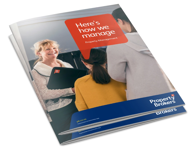Your Guide to Healthy Homes Compliance in New Zealand
Wednesday, 16 April 2025

By continuing, you agree to our terms of use and privacy policy
Instructions on how to reset your password will be sent to the email below.
Your password reset link has been sent. Please check your inbox and follow the instructions provided.
Wednesday, 16 April 2025

New Zealand’s Healthy Homes Standards were introduced to make rental properties warmer, drier, and healthier - and they’re a game changer for both tenants and landlords. But as practical and positive as they are, these standards have also introduced a wave of compliance confusion.
Landlords across the country are navigating a complex mix of deadlines, paperwork, and upgrades. Tenants are asking questions, property conditions vary, and official government checklists - while helpful - don’t offer a clear plan of action when work needs to be done.
That’s where we come in.
At Property Brokers, our property managers do more than just explain the standards. We help landlords navigate, manage, and complete the work required - smarter, faster, and with better outcomes for everyone involved.
The Healthy Homes Standards outline the minimum requirements for heating, insulation, ventilation, moisture and drainage, and draught stopping in all rental homes across New Zealand. For official details, you can visit Tenancy Services' Healthy Homes hub. But if you're after actionable advice tailored to your property, you’re in the right place.
We’ve translated the compliance requirements into something landlords can actually work with - and more importantly, we can do the work for you.
| Standard | What the law requires | How Property Brokers helps |
|---|---|---|
| Heating | Fixed heating source in the main living area that meets a minimum kW requirement | We assess the size of the room, recommend compliant options, and coordinate trusted installers |
| Insulation | Ceiling and underfloor insulation must meet 2008 Building Code or be topped up | We check insulation levels and arrange upgrades if needed — no guesswork required |
| Ventilation | Windows that open in key rooms and extractor fans in kitchens and bathrooms | We confirm existing systems and bring in licensed electricians for any upgrades |
| Moisture & Drainage | Efficient drainage and ground moisture barriers where required | We inspect subfloors and coordinate professional installation if barriers are needed |
| Draught Stopping | All gaps and holes that cause draughts must be sealed | We identify non-compliant areas and send in professionals to get them sealed up |
The law: A fixed heating device in the main living room that meets a specific heating capacity.
Our tip: Many landlords assume existing heat pumps will do - but not all meet the new minimum capacity. We calculate the correct heating requirement based on room size and condition, and if an upgrade’s needed, we manage the whole process from quote to install.
The law: Ceiling and underfloor insulation must be up to standard, or upgraded.
Our tip: Insulation degrades over time — and “existing” doesn’t always mean “compliant.” We bring in certified professionals to inspect and insulate where needed, ensuring you’re covered for both current standards and future changes.
Our tip: Older homes are often the trickiest here. We assess what’s in place and whether the fan specs meet compliance - and if not, we’ll sort new fans through licensed electricians.
The law: Proper drainage (gutters, downpipes, etc.) and ground moisture barriers in enclosed subfloors.
Our tip: Many landlords don’t even know they have a subfloor issue. We’ll inspect, advise, and coordinate the install of moisture barriers if needed - no disruption to tenants.
The law: All gaps or openings that let in draughts must be blocked.
Our tip: We’ve seen everything from unsealed cat doors to floorboard gaps. We do a full property walk-through and send in the right tradie to make sure you tick the box - and stay compliant long-term.
Sometimes, compliance is just the starting point. One of our landlords in Hawke’s Bay wanted to bring their 1970s rental up to Healthy Homes spec - but also wanted to add long-term value. We managed a full insulation and heating upgrade, coordinated new paint and flooring, and helped re-market the property at a 12% rent increase. Better still, the tenants were thrilled and stayed on.
Another investor in Manawatū was overwhelmed by multiple properties needing different levels of work. Our team created a compliance timeline, arranged trusted tradespeople, managed tenant comms, and completed the work well before the deadline.
Don’t let compliance become a headache. Whether you need a simple assessment or full-service renovation management, Property Brokers can help. Explore our property management fees or talk to one of our local property managers today.

Want to know more about Property Brokers' superior property management service? Check out our FREE guide here!
From the top of the North through to the deep South, our salespeople are renowned for providing exceptional service because our clients deserve nothing less.
Managing thousands of rental properties throughout provincial New Zealand, our award-winning team saves you time and money, so you can make the most of yours.
With a team of over 850 strong in more than 88 locations throughout provincial New Zealand, a friendly Property Brokers branch is likely to never be too far from where you are.